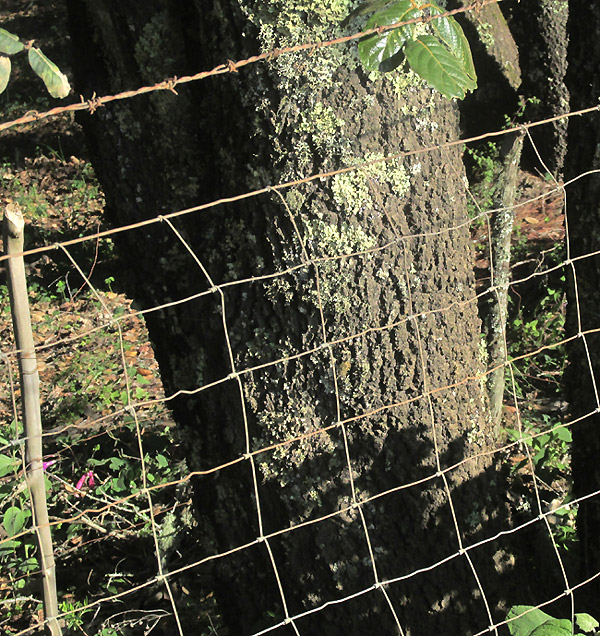Excerpts from Jim Conrad's
Naturalist Newsletter
Entry from field notes dated September 2, 2023, taken in Los Mármoles National Park in the Eastern Sierra Madre mountains, Hidalgo state, MÉXICO; along road leading to Puerto de Piedra, which branches off the road between Trancas {on maps designated "Morelos (Trancas)"} and Nicolás Flores; limestone bedrock; elevation ~2,550m (~8,400ft); ~N20.81°, ~W99.23°
LEATHER LEAF MEXICAN OAK

Healthy acorns forming on any oak tree, as seen above, always makes me feel good, not only because the acorns are so important to wildlife, but also because they're simply beautiful to see. This oak' leaves also were were especially handsome, being somewhat leathery and shiny. Many of the tree's branches bore large buds but no leaves. Probably that was because here we are at the end of a second year of continuing severe drought; the tree had too little water this year for a full crop of leaves.

Above, immature, green acorn nuts are topped by remnants of the flower's styles. The nuts gradually diminish in diameter toward their tops. The lower acorn, more mature, is turning brown. Later I'd learn that a feature to note for identification is that the rims of the nuts' cups do not curve inward, but rather remain directed upward to their very edges. Notice that the stem bearing the acorns is white with white, matted hairs.

The leaves seen from below, by themselves, reveal this oak's identity. First, blades are widest above their middles, not at their middles or below. Blade margins are curled under and, very important to notice, certain low teeth toward the blade's wide tips are toothed, with tooth tips bearing minute needle-like spines. Further, blade undersurfaces are so matted with hairs that their green faces can't be seen. Importantly, the hairy surface isn't really white, but rather a pale brown or tan hue. Already we have enough to recognize the tree's identity, but here's our tree's edge-of-pasture, fenced-in, roadside trunk just for good measure:

The 2021 work by José Luis Villaseñor and others entitled "Riqueza y distribución de la flora vascular del estado de Hidalgo, México" reports that here in upland central Mexico's Hidalgo state an astonishing 57 oak species are documented. That explains why the above obscure details must be noted for identification. Still, this species displays such a distinctive combination of characters that it stands out. In this part of upland central Mexico, if your oak's leaves are widest above their middles and bear tiny, needle-like spines at their tooth tips, and the blades' undersurfaces are so matted-hairy with pale brown or tan hairs that the blades' green tissue can't be seen, you have QUERCUS CRASSIFOLIA, often named the Leather Leaf Mexican Oak.
Leather Leaf Mexican Oaks bear an English name despite not being native to English-speaking lands, partly because sometimes the species is planted as an ornamental, growing up to 25m high (82ft). Its native distribution stretches from the highlands of northwestern Mexico south into Guatemala.
Being a particularly large, robust oak species, thus a prime target for those looking for timber trees, wood for handle-making, fenceposts, firewood and the rest, Quercus crassifolia has been particularly hard hit. The 2017 study by Montserrat Gorgonio-Ramírez entitled "Diversidad y estructura genética de Quercus crassifolia en sitios de manejo forestal y uso local en Sierra Juárez, Oaxaca" addressed long-term effects of the disappearance of the overuse of Quercus crassifolia. They concluded that "The excessive extraction of individuals affects the population viability and regeneration of the species, which in the future may have a negative effect on the genetic diversity and the processes of genetic differentiation among populations."
Quercus crassifolia lies at the heart of a complex of similar-looking species and hybrids, implying that with this species evolution has found a particularly robust taxon, and now is busily experimenting with evolving variations on the Quercus crassifolia theme. M. Lucía Vázquez and Kevin Nixon in their 2013 study "Taxonomy of Quercus crassifolia (Fagaceae) and morphologically similar species in Mexico," describe Quercus crassifolia as one of the parent species of the fertile hybrid Quercus x dysophylla.